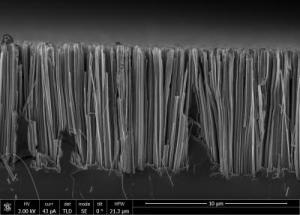Oct 19 2016
 These silicon nanowires were obtained with the help of new eco-friendly method developed by Russian scientists. Toxic hydrofluoric acid is replaced by harmless ammonium fluoride. Credit: Kirill Gonchar
These silicon nanowires were obtained with the help of new eco-friendly method developed by Russian scientists. Toxic hydrofluoric acid is replaced by harmless ammonium fluoride. Credit: Kirill Gonchar
Researchers from the Faculty of Physics at the Lomonosov Moscow State University have developed a new eco-friendly method to make silicon nanowires. This process may allow researchers to replace hydrofluoric acid (HF) with ammonium fluoride (NH4F).
Silicon nanowires are used in various technologies, almost parallel to other nanostructures, like wires. The diameter of nanowires ranges from 50 to 200 nm, and the distance between structures ranges from 100 to 500 nm.
Depending on etching time, the length of nanowires could range from 100 nm to up to 10s of microns. The perspectives of silicon nanowires’ application in micro- and optoelectronics, sensorics, PV and photonics have caused interest for these materials.
Silicon nanowires could also be used in biomedicine because silicon nanostructures are biodegradable materials, which mean they self-destruct after some period of time in an organism. Nanostructures are not harmful for an organism in limited concentrations. However, hydrofluoric acid (HF), used to produce silicon nanowires by a conventional method, is extremely harmful.
Making silicon nanowires using metal-assisted etching can be possible because of chemical etching of silicon wafers, where metal nanoparticles (for example, silver nanoparticles) trigger etching.
We've used a two-step method of etching. At the first stage silver nanoparticles were deposited on the surface of a silicon wafer. But this deposition didn't produce a level layer but different island regions. At the second stage the silicon wafer was etched right in the places, covered with silver. Because of this, those silicone sheet places, which were uncovered with silver, turned into nanowires. Silver nanoparticles fell into the silicone sheet. And the more etching was lasting the longer nanowires were got at the output. At the end silver was removed with the help of nitric acid.
Kirill Gonchar, Junior Researcher, Lomonosov Moscow State University
The Lomonosov Moscow State University researchers have substituted ammonium fluoride for toxic and dangerous hydrofluoric acid at each stages of chemical etching. They also have examined optical properties of these nanowires, produced by this method, and evaluated them with nanowires, obtained by conventional method, depending on the use of hydrofluoric acid.
Kirill Gonchar shares, how this idea of using ammonium fluoride has emerged in nanowires synthesis.
The idea of ammonium fluoride application wasn't new, it was borrowed from experiments of porous silicon obtaining, which took place 20 years ago. Ammonium fluoride was also used there instead of hydrofluoric acid. There were similar projects where nanowires were produced in ammonium fluoride, however, there was no replacement at all etching stages. We've studied optical properties of the nanowires we got and proved that they don't differ much from nanowires, obtained by conventional method.
Kirill Gonchar, Junior Researcher, Lomonosov Moscow State University
Silicon nanowires are produced by metal-assisted etching and they could be used for making new silicon-based sensors and photonic devices. Kirill Gonchar explains, that nanowires are showing potential as sensory elements of optical sensors for various substances.
It happens due to the increase of the Raman effect signal intensity, a "finger print" of a substance, and secondly, it is due to sensitivity to the presence of various gases, for example oxygen (a relevant patent has already been registered on this)
Furthermore, structures that contain silicon nanowires could be utilized in antireflection coating for solar cells. The obtained silicon nanowires reflect 1-2% of light in the visible range, while normal silicon reflects about 30%.